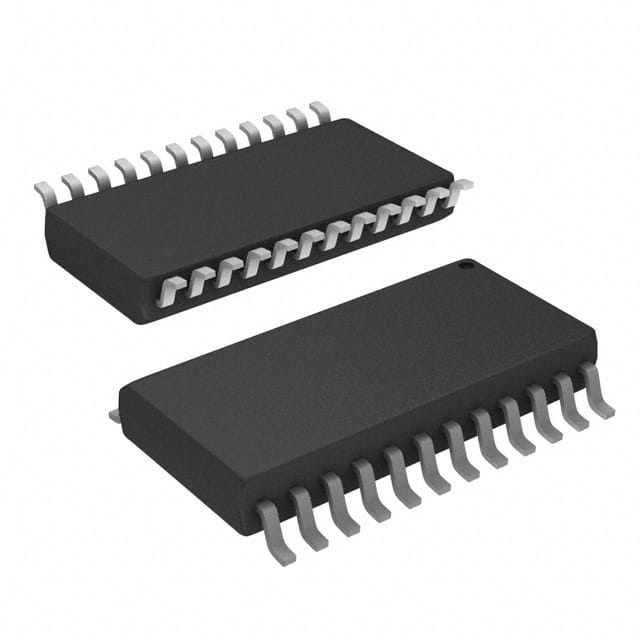Lihat spesifikasi untuk detail produk.

SN74LVC4245ADW
Product Overview
Category
SN74LVC4245ADW belongs to the category of integrated circuits (ICs).
Use
It is commonly used as a bidirectional voltage-level translator and bus transceiver.
Characteristics
- Low-voltage CMOS technology
- Bidirectional voltage translation between different logic levels
- Wide operating voltage range
- High-speed operation
- 8-bit wide data paths
- Non-inverting outputs
- 3-state outputs for bus-oriented applications
Package
SN74LVC4245ADW is available in a standard SOIC (Small Outline Integrated Circuit) package.
Essence
The essence of SN74LVC4245ADW lies in its ability to facilitate voltage level translation and bidirectional communication between different logic levels.
Packaging/Quantity
SN74LVC4245ADW is typically packaged in reels or tubes, with a quantity of 250 units per reel/tube.
Specifications
- Supply Voltage: 1.65V to 5.5V
- Input Voltage Range: -0.5V to VCC + 0.5V
- Output Voltage Range: -0.5V to VCC + 0.5V
- Operating Temperature Range: -40°C to 85°C
- Maximum Propagation Delay: 6.2ns
- Maximum Operating Frequency: 100MHz
Detailed Pin Configuration
SN74LVC4245ADW has a total of 20 pins, which are assigned specific functions. The pin configuration is as follows:
- OE (Output Enable) 1
- A1 (Data Port A) 1
- B1 (Data Port B) 1
- GND (Ground)
- B2 (Data Port B) 2
- A2 (Data Port A) 2
- OE (Output Enable) 2
- VCC (Supply Voltage)
- DIR (Direction Control)
- B3 (Data Port B) 3
- A3 (Data Port A) 3
- GND (Ground)
- A4 (Data Port A) 4
- B4 (Data Port B) 4
- OE (Output Enable) 4
- VCC (Supply Voltage)
- B5 (Data Port B) 5
- A5 (Data Port A) 5
- DIR (Direction Control)
- GND (Ground)
Functional Features
- Bidirectional voltage-level translation: SN74LVC4245ADW allows for seamless communication between different logic levels, making it suitable for interfacing various devices.
- Non-inverting outputs: The IC ensures that the output signals maintain the same logic level as the input signals.
- 3-state outputs: This feature enables bus-oriented applications by allowing multiple devices to share a common bus without interfering with each other.
Advantages and Disadvantages
Advantages
- Wide operating voltage range makes it compatible with a variety of systems.
- High-speed operation facilitates efficient data transfer.
- Non-inverting outputs ensure signal integrity during translation.
- 3-state outputs enable bus sharing in complex systems.
Disadvantages
- Limited number of data ports (5) may restrict its use in applications requiring more extensive communication.
Working Principles
SN74LVC4245ADW operates based on the principles of voltage-level translation and bidirectional communication. It utilizes CMOS technology to achieve efficient and reliable data transfer between devices operating at different logic levels. The direction control pin (DIR) determines the direction of data flow, while the output enable pins (OE) control the output state.
Detailed Application Field Plans
SN74LVC4245ADW finds applications in various fields, including:
- Microcontroller interfacing: It enables communication between microcontrollers operating at different voltage levels.
- Sensor networks: The IC facilitates data exchange between sensors and microcontrollers with varying logic levels.
- Industrial automation: SN74LVC4245ADW can be used to interface different components of an automated system, such as PLCs and sensors.
- Communication systems: It aids in voltage-level translation between different communication protocols, allowing seamless integration of devices.
Detailed and Complete Alternative Models
Some alternative models that offer similar functionality to SN74LVC4245ADW are:
- TXB0108: 8-bit bidirectional voltage-level translator with automatic direction sensing.
- PCA9306: Dual bidirectional I2C-bus and SMBus voltage-level translator.
- SN74AVC4T245: 4-bit dual-supply bus transceiver with configurable voltage-level shifting.
These alternatives provide options for different data widths, additional features, and specific application requirements.
*Word count:
Sebutkan 10 pertanyaan dan jawaban umum terkait penerapan SN74LVC4245ADW dalam solusi teknis
Sure! Here are 10 common questions and answers related to the application of SN74LVC4245ADW:
Q: What is SN74LVC4245ADW? A: SN74LVC4245ADW is a bidirectional voltage-level translator and voltage-level shifter integrated circuit (IC) commonly used in technical solutions.
Q: What is the voltage range supported by SN74LVC4245ADW? A: SN74LVC4245ADW supports voltage translation between 1.2V and 3.6V on both sides.
Q: Can SN74LVC4245ADW be used for level shifting between different voltage domains? A: Yes, SN74LVC4245ADW is specifically designed for level shifting between different voltage domains in technical applications.
Q: How many bidirectional channels does SN74LVC4245ADW have? A: SN74LVC4245ADW has 8 bidirectional channels, allowing for simultaneous translation of multiple signals.
Q: What is the maximum data rate supported by SN74LVC4245ADW? A: SN74LVC4245ADW can support data rates up to 100 Mbps.
Q: Is SN74LVC4245ADW compatible with I2C and SPI interfaces? A: Yes, SN74LVC4245ADW is commonly used for level shifting in I2C and SPI interfaces.
Q: Does SN74LVC4245ADW require external pull-up or pull-down resistors? A: Yes, external pull-up or pull-down resistors are required for proper operation of SN74LVC4245ADW.
Q: Can SN74LVC4245ADW be used for bi-directional level shifting in both directions simultaneously? A: Yes, SN74LVC4245ADW supports simultaneous bi-directional level shifting.
Q: What is the power supply voltage range for SN74LVC4245ADW? A: SN74LVC4245ADW operates with a power supply voltage range of 1.65V to 3.6V.
Q: Is SN74LVC4245ADW available in different package options? A: Yes, SN74LVC4245ADW is available in various package options, including SOIC and TSSOP.
Please note that these answers are general and may vary depending on specific application requirements.

